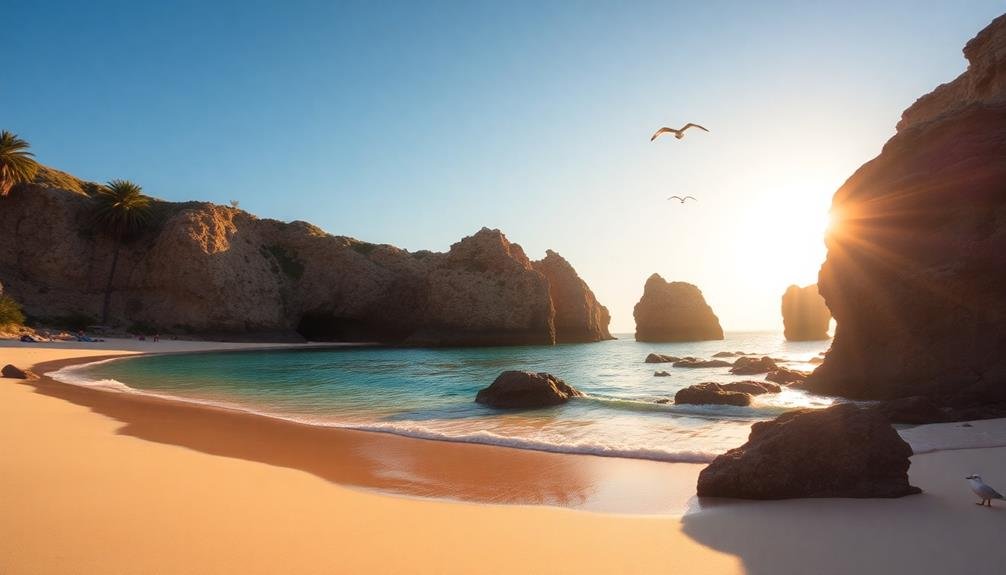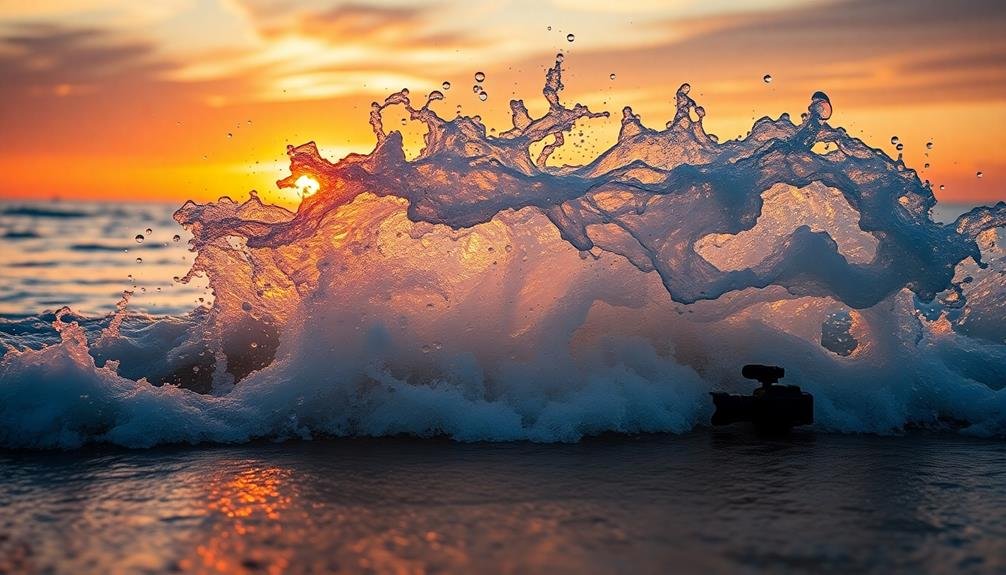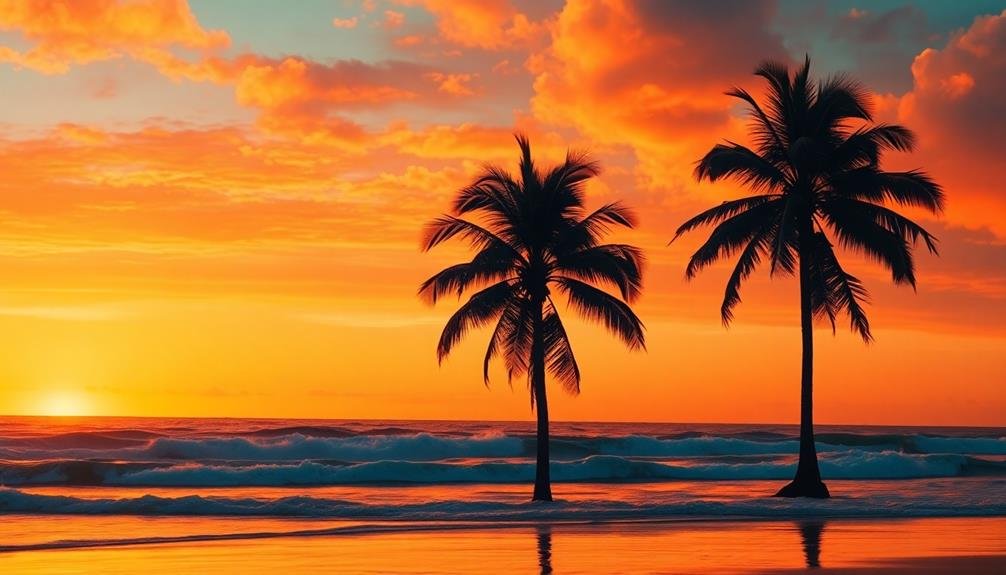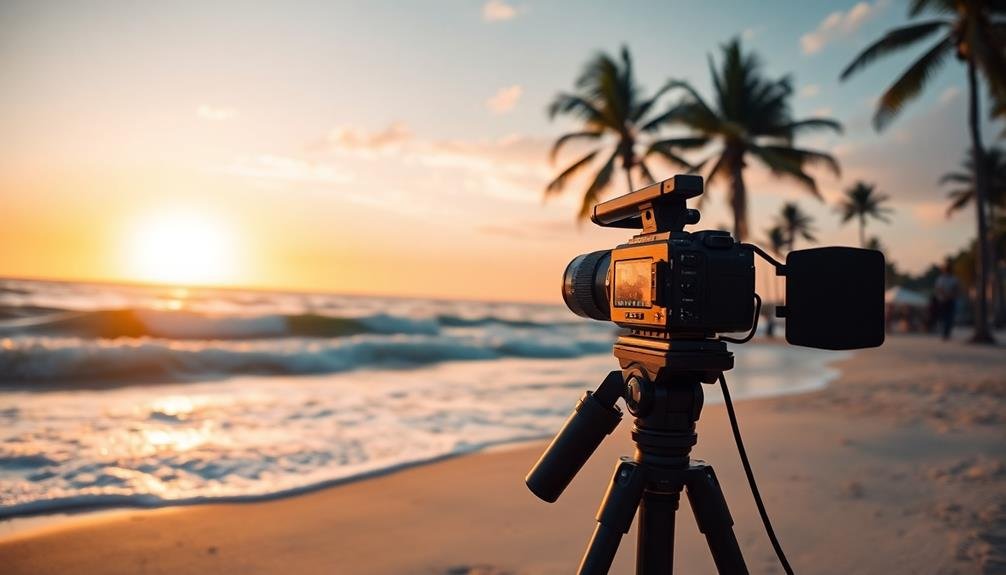To capture breathtaking beach scenes, start by selecting a location with unique features and ideal lighting conditions. Master golden hour shots by scouting in advance and using wide-angle lenses with polarizing filters. Incorporate drone footage for dramatic reveals and orbits, ensuring smooth movements. Experiment with shutter speeds to capture dynamic water movements, from frozen droplets to ethereal flows. In post-production, fine-tune your color grading to enhance the natural beauty of ocean hues and warm sunlight. By combining these techniques, you'll elevate your beach footage from ordinary to cinematic. Dive deeper into each aspect to truly transform your seaside cinematography.
Choosing the Perfect Beach Location

When scouting for the ideal beach location for your cinematic shoot, scope out spots that offer diverse visual elements. Look for beaches with unique features like rocky outcrops, sand dunes, or interesting vegetation. These elements can add depth and texture to your shots, creating more visually compelling scenes.
Consider the direction of the sun and how it'll affect your lighting throughout the day. Beaches facing east or west can provide stunning sunrise or sunset shots, while north or south-facing beaches offer more consistent lighting.
Don't forget to check tide schedules, as they'll impact your available shooting area and potential reflections on wet sand.
Accessibility is essential. Make certain you can easily transport your equipment to the location. Look for nearby parking or loading zones, and scout for power sources if needed.
Research local permits and restrictions, as some beaches may have limitations on commercial filming.
Evaluate the beach's surroundings. Are there interesting landmarks, piers, or cliffs that could enhance your shots?
Also, consider the beach's atmosphere. A secluded cove might be perfect for intimate scenes, while a bustling shoreline could work well for lively, energetic shots.
Mastering Golden Hour Lighting

Bathed in warm, ethereal light, the golden hour offers filmmakers a magical window for capturing breathtaking footage. To harness this fleeting moment, you'll need to plan meticulously and act swiftly.
Start by scouting your location in advance, noting the sun's position and how it interacts with the landscape. Use apps like Sun Seeker to predict exact golden hour times and sun angles.
Set up your equipment well before the golden hour begins. Opt for a wide-angle lens to capture the expansive beauty of the beach, and consider using a polarizing filter to enhance the sky's colors and reduce glare from the water.
Adjust your camera settings for the changing light conditions; start with a lower ISO and wider aperture to maximize the warm glow.
Experiment with silhouettes by positioning your subjects against the sun, or use a reflector to bounce light onto faces for a softer, more flattering look.
Don't forget to capture both wide shots and close-ups to add variety to your footage. As the light rapidly changes, be prepared to adjust your settings and compositions quickly.
Drone Flight Patterns for Impact

Drones have revolutionized cinematic storytelling, offering perspectives that were once impossible to achieve. When filming beach scenes, you'll want to master a few key flight patterns to capture truly impactful footage.
Start with the classic reveal shot, slowly ascending from behind an object to disclose the expansive coastline. This creates a sense of anticipation and awe for your audience.
Next, try the orbit technique. Circle your subject, whether it's a surfer catching waves or a lone figure walking along the shore. This dynamic movement adds depth and dimension to your shots.
For sweeping vistas, employ the altitude adjustment pattern, gradually increasing your drone's height to showcase the beach's full scope.
To make your drone footage even more cinematic, consider these additional tips:
- Use slow, smooth movements to mimic traditional camera work
- Incorporate natural elements like waves or clouds into your compositions
- Experiment with different angles, including top-down views for unique perspectives
Remember to always follow local regulations and prioritize safety when flying your drone.
With practice and creativity, you'll soon be capturing breathtaking beach scenes that rival professional productions.
Capturing Dynamic Water Movements

From gentle ripples to crashing waves, water's dynamic nature offers endless opportunities for enchanting footage. To capture these mesmerizing movements, you'll need to master a few key techniques.
First, experiment with shutter speed. Use faster speeds to freeze water droplets mid-air, creating a crisp, high-energy look. Slower speeds will blur the water's motion, resulting in a dreamy, ethereal effect. Don't forget to adjust your aperture and ISO accordingly to maintain proper exposure.
Consider your camera's position relative to the water. Low angles can make waves appear more dramatic, while shooting from above provides a unique perspective on patterns and currents.
Here's a quick guide to water movement types and recommended techniques:
| Water Movement | Shutter Speed | Camera Angle | Lens Type | Time of Day |
|---|---|---|---|---|
| Gentle Ripples | 1/30 – 1/60 | High | Wide | Golden Hour |
| Breaking Waves | 1/250 – 1/500 | Low | Telephoto | Midday |
| Waterfalls | 1/2 – 1 sec | Eye-level | Mid-range | Overcast |
| Splashes | 1/1000+ | Close-up | Macro | Any |
| Reflections | 1/60 – 1/125 | Low | Wide | Sunrise/set |
Remember to protect your gear from water damage and always prioritize safety when filming near the ocean or other bodies of water.
Post-Production Color Grading Techniques

Color grading is the secret sauce that can transform your raw footage into cinematic masterpieces. When working on beach scenes, you'll want to enhance the natural beauty while creating a cohesive look. Start by adjusting the white balance to capture the warm tones of sunlight or the cool hues of ocean waters.
Next, fine-tune your exposure and contrast to bring out details in both highlights and shadows.
For a polished beach film, consider these color grading techniques:
- Use a teal and orange color palette to emphasize the contrast between sky and sand
- Boost saturation in blues and greens to make the ocean pop
- Add a subtle vignette to draw the viewer's eye to the center of the frame
Don't forget to pay attention to skin tones, especially if you're featuring people in your beach scenes. You'll want to keep them natural-looking while still fitting within your overall color scheme.
Frequently Asked Questions
What Equipment Is Essential for Beach Filmmaking Beyond Standard Cameras?
You'll need a sturdy tripod, ND filters, and a weatherproof camera bag. Don't forget a waterproof housing for underwater shots. Bring extra batteries, SD cards, and a portable power bank. A drone can capture stunning aerial views.
How Do You Protect Gear From Sand and Saltwater Damage?
You'll need to protect your gear from sand and saltwater. Use waterproof cases, silica gel packets, and lens filters. Clean equipment daily with microfiber cloths. Keep gear elevated and covered when not in use. Don't change lenses on the beach.
What Permits Are Typically Required for Commercial Beach Filming?
You'll typically need a filming permit from the local government or beach authority. Don't forget to secure location releases and special use permits. If you're using drones, you'll also need FAA clearance in many areas.
How Can You Minimize Environmental Impact While Filming on Beaches?
You can minimize environmental impact by sticking to designated paths, avoiding wildlife areas, using eco-friendly equipment, and packing out all trash. Don't disturb sand dunes or vegetation. Always follow local regulations and leave no trace behind.
Are There Specific Safety Precautions for Filming in Coastal Environments?
When filming in coastal environments, you'll need to watch for tides, rip currents, and slippery rocks. Always check weather forecasts, bring safety gear, and have a first aid kit. Don't turn your back on the ocean.
In Summary
You've learned the essentials for creating stunning beach cinematography. Now it's time to put these tips into action. Remember, location scouting, golden hour timing, and drone techniques are your keys to success. Don't forget to capture the water's mesmerizing movements and enhance your footage with expert color grading. With practice, you'll soon be crafting breathtaking beach scenes that rival Hollywood productions. So grab your gear, head to the shore, and start filming your masterpiece!

As educators and advocates for responsible drone use, we’re committed to sharing our knowledge and expertise with aspiring aerial photographers.




Leave a Reply